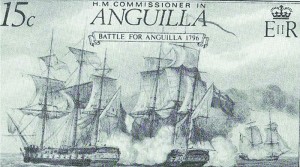
There are many famous Anguillian vessels. The names of sailing boats are legendary, even hereditary on thisIsland. But there is only one ship that literally savedAnguilla. David Carty lamented in 1997 that ‘history unfortunately does not recall the name of this sloop’….
Fortunately, we now know that she wasn’t a sloop, but in fact a small schooner. According to David Carty’s account, the ship left fromSandyHillBayand was driven so hard that the mast began to break.
The year was 1796 and slavery and sugar dominated the landscape.EnglandandFrancewere at War (again) and the French Revolution was in full-swing. The French Revolutionary Victor Hughes had brought the portable guillotine to theFrenchIslandofGuadeloupetwo years before and executed the wealthiest planters. He had also ‘exported’ the Revolution toSt Martin,Dominica, la Grenade, Saint-Vincent andSaint Lucia. In 1796, he ordered 470 men under citoyensAndre Senis and Labourtique from St Martin toAnguillawith instructions ‘to exterminate the inhabitants’.

The French force landed atRendezvousBayand quickly moved through the settlements;for four days they burned villages and pillaged plantations. Despite resistance, they sacked and burned the main town atCrocusBay. In the Valley they tore down the church and burned Wallblake House. Their advance was finally held at Sandy Hill Fort where the Anguillians melted the last of their fishing net weights to make musket balls.
Colonel Benjamin Gumbs said years after (1824) that he urged the men, saying,
I tell you what. I know nothing of marching and counter-marching, but my advice to you is wait till the enemy comes close and then fire and load and fire again like the devil.
-Benjamin Gumbs,Anguilla’s Lieutenant Governor
Meanwhile a fast sailing schooner, which thanks to the Captain’s logbook we now know was the Margaret, was sent from Anguilla to St Kitts for help; on reaching St Kitts theAnguillaschooner found the 28-gun British frigate, HMS Lapwing. Sailing with the frigate, both ships proceeded quickly toAnguilla. Arriving at night, they saw the main settlements and plantations in flames. They engaged the enemy’s ships: a 26-gun French Frigate Le Decius (440 men), a large Gun Brig Le Vallaint(280 men) and Le Promenad, an armed schooner (100 men). In the action, Peter Gumbs and the pilot were killed but the French ships Le Decius andLe Vallainttaken and destroyed.
The timely intervention of the Margaret and Lapwing caused the French to immediately break off their siege of Sandy Hill. In their hasty retreat, many French soldiers were left stranded. Having surrendered, they were imprisoned in the burned out cellars of the Crocus Hill Court House (a Heritage Trail site). Realizing the extent of destruction, enraged Anguillians led by the Governor’s grandson swarmed the make shift prison and slaughtered the French in their cells.
Two service medals were awarded for the engagement. One of these, awarded to Seaman William Levey is preserved at theNationalMaritimeMuseuminGreenwich,England. TheBattlefor Anguilla represents a bloody turning point inAnguilla’s history. Although the French were defeated and prevented from taking over Anguilla, theIsland’s economy was devastated. TheIsland’s capital was never rebuilt and the plantations doomed to failure. As a result 19th centuryAnguillawas characterized by increasing hardship and abject poverty.







